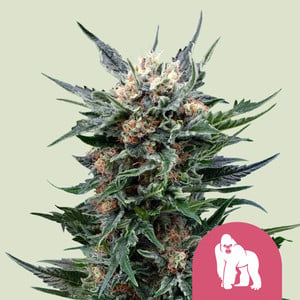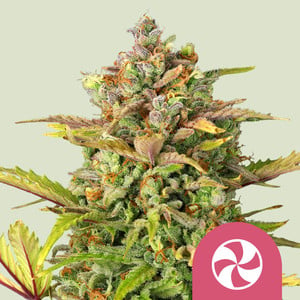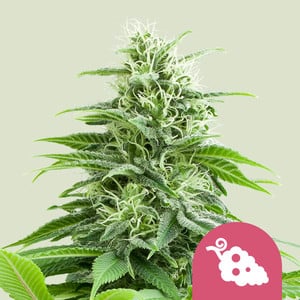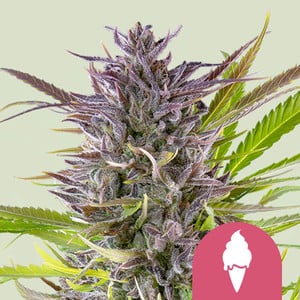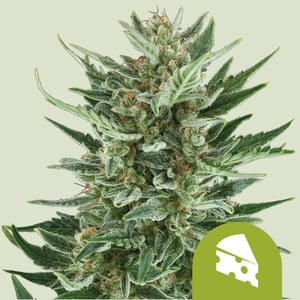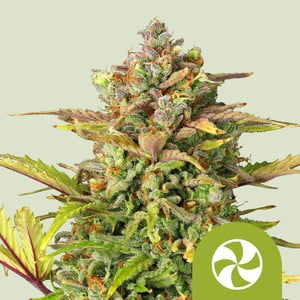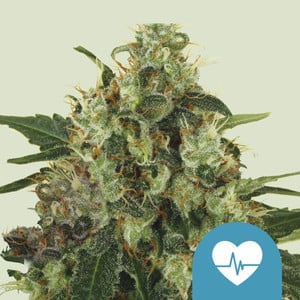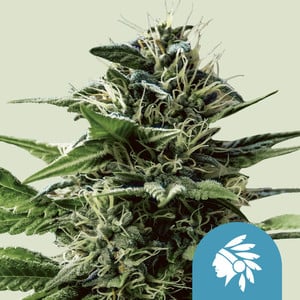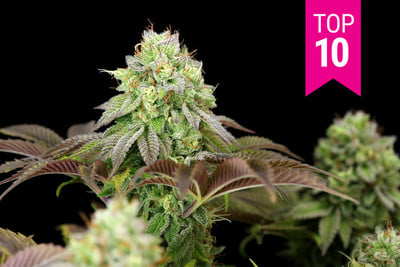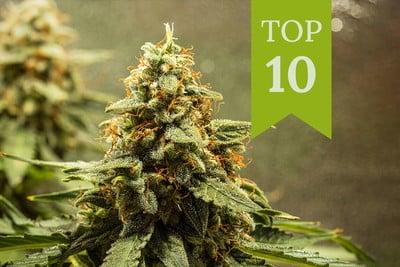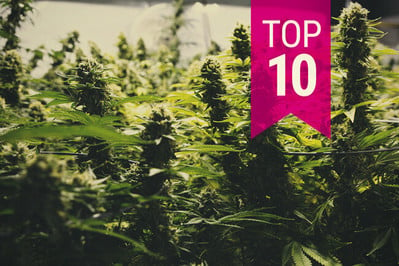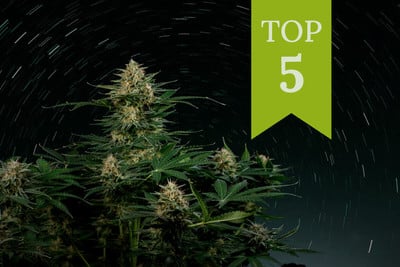Cannabis Seeds: Regular vs Feminised vs Autoflowering vs CBD
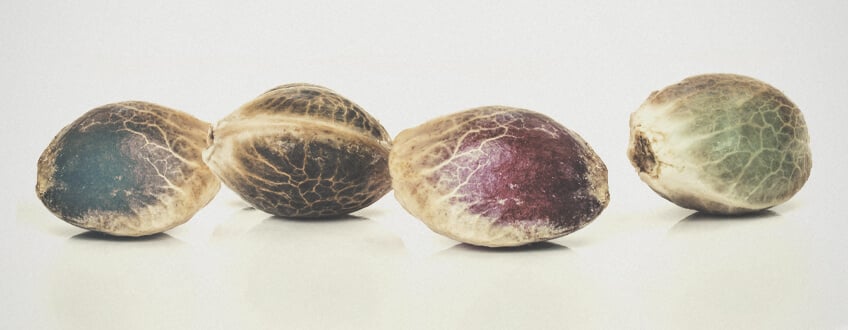
Learn the difference between cannabis seed types.
Contents:
- 1. Cannabis: A diverse species
- 2. Regular
- 2.1. Top three regular strains
- 3. Feminised
- 3.1. Top three feminised strains
- 4. Autoflowering
- 4.1. Top three autoflowering strains
- 5. CBD
- 5.1. Top three CBD strains
- 1. Cannabis: A diverse species
- 2. Regular
- 2.1. Top three regular strains
- 3. Feminised
- 3.1. Top three feminised strains
- 4. Autoflowering
- 4.1. Top three autoflowering strains
- 5. CBD
- 5.1. Top three CBD strains
Use the guide below to learn what makes each type of cannabis different. By the end, you'll know which type flowers the fastest, which makes the best clones, and which variety to use for breeding.
CANNABIS: A DIVERSE SPECIES
Cannabis seeds are available in four primary categories: regular, feminised, autoflowering, and CBD. Each type features its own unique advantages and disadvantages and appeals to different cultivators depending on their goals.
If you’re looking to enter the world of breeding—or perhaps you want genetically sturdy clones—then regular seeds are the way to go.
You’ll want to start off with feminised seeds if your only aim is a canopy full of colas. These seeds minimise the chances of a male turning up in the growing room.
Many growers value speed above all else. If you want to harvest in as little time as possible, autoflowering seeds fit the bill.
CBD strains offer a wide range of benefits and provide a clear-headed effect without a high.
Let’s take a dive into each of these four types of cannabis seeds. We’ll explore the pros and cons of each variety, whether they’re right for you, and the best strains in each category.
REGULAR
Regular cannabis seeds have a 50% chance of emerging as either males or females—just as nature intended.
Because they produce males, regular seeds are popular among breeders creating new strains. Males produce pollen that breeders use to fertilise female flowers, creating the next generation of seeds.
Regular seeds are available in many different forms. You’ll find indica-dominant, sativa-dominant, high-THC, and high-CBD varieties.
| PROS | CONS |
| Required for breeding and creating new strains | Can be unpredictable; germinating seeds is a gamble regarding sex |
| Even chance of producing male and female plants | Growers might misidentify males and females |
| Produce vigorous cuttings ideal for making healthy clones | Accidental males in the grow room can lead to the fertilisation of flowers |
| Breeders can create a pollen bank using male plants | Requires growers to set up separate grow tents or greenhouses for male and female plants |
| Wide variety of different strains available—both classic and modern genetics | - |
| PROS | CONS |
| Required for breeding and creating new strains | Can be unpredictable; germinating seeds is a gamble regarding sex |
| Even chance of producing male and female plants | Growers might misidentify males and females |
| Produce vigorous cuttings ideal for making healthy clones | Accidental males in the grow room can lead to the fertilisation of flowers |
| Breeders can create a pollen bank using male plants | Requires growers to set up separate grow tents or greenhouses for male and female plants |
| Wide variety of different strains available—both classic and modern genetics | - |
HOW ARE REGULAR GENETICS MADE?
Regular genetics are completely natural. They are the result of how cannabis emerged in nature. There’s no tampering or tweaking involved.
Purebred regular genetics stem all the way back to landrace ancestors found all over the world, from the mountains of India to the beaches of Jamaica.
Breeders have also created regular hybrids by combining the genetics of two different subspecies. This results in a progeny that expresses the traits of both parent strains.
ARE REGULAR GENETICS FOR YOU?
If you want an even mix of male and female plants, then regular cannabis seeds are for you. Having both sexes at your disposal will enable you to create your own strains.
You'll be able to select plants with the traits you like and use them to create your own customised varieties. You can modify anything—the terpene profile, cannabinoid content, productivity, and size.
You’ll also want to grow out regular seeds if you plan on taking cuttings. Cloning will allow you to skip the germination phase and create an exact genetic copy of a selected plant. Only regular plants produce fully viable and vigorous clones.
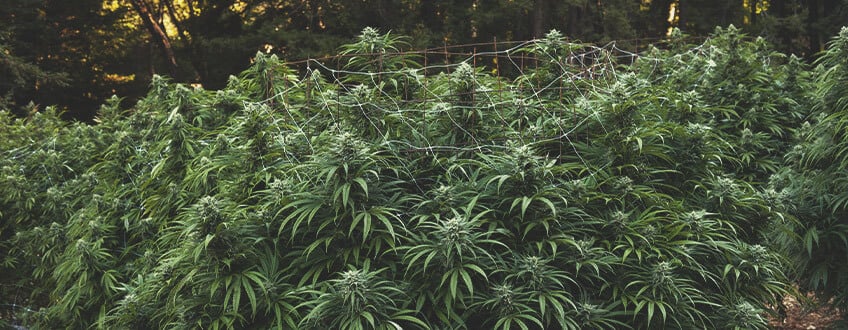
FEMINISED
Feminised seeds were created to maximise the chances of germinating female plants. To be precise, the chances of a female emerging are around 99.9%. The odds are in your favour if you’re seeking flowers over pollen sacs!
| PROS | CONS |
| Almost guaranteed to produce female plants | Aren’t suitable for breeding purposes |
| Eliminate the 50:50 genetic gamble | Produce less viable clones; growers need to start from seed in most cases |
| Ideal for growers looking for nothing but dank buds | Can sometimes turn into hermaphrodites due to bad genetics or environmental stress |
| Streamline the growing process and are cost-effective | - |
| PROS | CONS |
| Almost guaranteed to produce female plants | Aren’t suitable for breeding purposes |
| Eliminate the 50:50 genetic gamble | Produce less viable clones; growers need to start from seed in most cases |
| Ideal for growers looking for nothing but dank buds | Can sometimes turn into hermaphrodites due to bad genetics or environmental stress |
| Streamline the growing process and are cost-effective | - |
HOW ARE FEMINISED GENETICS MADE?
Feminised genetics are made by essentially crossing one female with another. Breeders use two techniques to force female plants to produce pollen. They then fertilise another female, whose flowers produce a generation of feminised seeds.
We know what you’re thinking; how on Earth can a female suddenly grow balls?! Well, there are two different ways to achieve this.
By stopping the production of ethylene levels in plant tissues, breeders can force female plants to produce pollen sacs. Various chemical agents can be used to catalyse this process—colloidal silver being the safest option.
The second method involves relying on nature's deep desire to procreate. If female cannabis plants are left unfertilised, they sometimes take matters into their own hands.
Occasionally, they’ll flip sexes in an attempt to fertilise themselves. They produce oddly shaped pollen-producing structures known descriptively as “bananas”.
Breeders collect this “female pollen” and use it to fertilise female flowers to produce feminised seeds.
ARE FEMINISED GENETICS FOR YOU?
If you want nothing but resinous flowers from your grow, then feminised seeds are for you.
You’ll save a tremendous amount of time not having to sift males out of your growing space. You can rest easy knowing that your grow tent or garden will remain pollen-free.
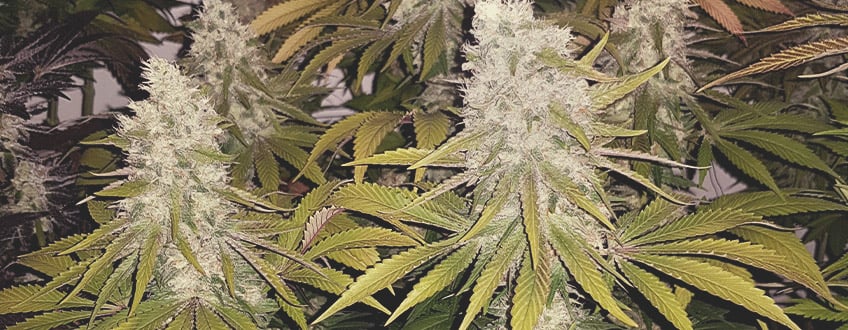
TOP THREE FEMINISED STRAINS
Do feminised strains tickle your fancy? If so, check out these three top-quality specimens below.
• Royal Gorilla produces outrageous levels of THC.
Royal Gorilla
|
|
Sour Dubb x Chem Sis x Chocolate Diesel |
|
|
500 - 550 gr/m2 |
|
|
90 - 160 cm |
|
|
8 - 10 weeks |
|
|
THC: 27% |
|
|
Sativa 50% Indica 50% |
|
|
550 - 600 gr/plant |
|
|
130 - 170 cm |
|
|
Middle of October |
|
|
Calming, Clear |
• Sweet ZZ will pump out a rewarding indoor yield.
Sweet ZZ
|
|
Grape Ape x Grapefruit |
|
|
550 - 600 gr/m2 |
|
|
80 - 140 cm |
|
|
7 - 9 weeks |
|
|
THC: 22% |
|
|
Sativa 20% Indica 80% |
|
|
500 - 550 gr/plant |
|
|
160 - 200 cm |
|
|
Late September |
|
|
Calming, Stoned |
• Fruit Spirit will set your taste buds on fire.
Fruit Spirit
|
|
Blueberry x White Widow |
|
|
375 - 425 gr/m2 |
|
|
80 - 120 cm |
|
|
9 - 10 weeks |
|
|
THC: 18% |
|
|
Sativa 30% Indica 70% |
|
|
475 - 525 gr/plant |
|
|
175 - 220 cm |
|
|
Early October |
|
|
Clear |
AUTOFLOWERING
Autoflower strains get their name from their ability to flower without a change in the light cycle. They are easy to grow, fast to flower, and maintain stealthy sizes.
| PROS | CONS |
| No need to change the light cycle | Lower yield |
| Small and compacte | Typically less THC; not as potent as most photoperiod strains |
| Usually higher in CBD | Difficult to clone |
| Rapid flowering times | - |
| Hardy genetics make them easy to grow and beginner-friendly | - |
| Ideal for guerrilla growing | - |
| PROS | CONS |
| No need to change the light cycle | Lower yield |
| Small and compact | Typically less THC; not as potent as most photoperiod strains |
| Usually higher in CBD | Difficult to clone |
| Rapid flowering times | - |
| Hardy genetics make them easy to grow and beginner-friendly | - |
| Ideal for guerrilla growing | - |
HOW ARE AUTOFLOWERING GENETICS MADE?
Breeders create autoflowering seeds by using Cannabis ruderalis genetics—the subspecies that contains the autoflowering trait.
Cannabis ruderalis adapted to the shorter growing seasons and colder climates of Central and Eastern Europe, Russia, and Central Asia. The shorter summer in these regions forced the subspecies to begin flowering on its own accord.
Ruderalis doesn’t have time to mess around. These plants need to reproduce before the short summer comes to an end and the freezing temperatures of autumn grip the landscape.
They developed the ability to flower based on time and age, instead of a change in light exposure.
In contrast, indica and sativa subspecies are photoperiod varieties. They require shorter light cycles to trigger flowering—an environmental cue that signals the imminence of autumn and colder days ahead.
Growers rarely cultivate pure ruderalis plants. They are shrubby, small, low in THC, and produce low yields.
However, they are like gold for breeders. They use these plants to infuse well-known photoperiod strains with the autoflowering trait.
ARE AUTOFLOWERING GENETICS FOR YOU?
You’ll benefit from autoflowering seeds if you want a harvest as soon as physically possible. Maybe you want to boost turnover, or set up and take down your growing operation within a small window of time.
They’re also ideal if you have limited space. You can still achieve a good yield in a small tent by growing several plants and utilising the sea of green (SOG) method.
Autoflowering strains are well-suited to discreet growers. You can grow these small plants in modified buckets and boxes, and even conceal them among companion plants outdoors.
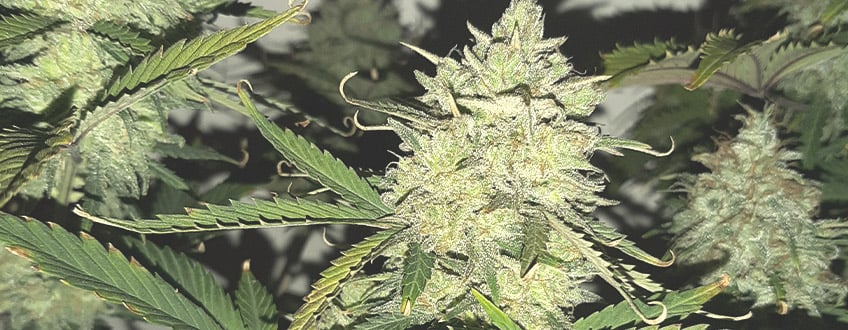
TOP THREE AUTOFLOWERING STRAINS
Autoflower growers enjoy a variety of options. The RQS catalogue features many different tastes, potencies, and varieties. Here are the top three.
• Green Gelato Automatic provides incredible levels of THC.
Green Gelato
|
|
Sunset Sherbet x Thin Mint Girl Scout Cookies |
|
|
500 - 700 gr/m² |
|
|
80 - 120 cm |
|
|
8 - 10 weeks |
|
|
THC: 27% |
|
|
Sativa 45% Indica 55% |
|
|
800 gr/plant |
|
|
150 - 200 cm |
|
|
Early October |
|
|
Clear, Physically Relaxing |
• Royal Cheese Automatic develops a productive canopy.
Royal Cheese Auto
|
|
Cheese x Royal Critical x Ruderalis |
|
|
425 - 475 gr/m2 |
|
|
60 - 100 cm |
|
|
7 - 8 weeks |
|
|
THC: 15% |
|
|
Sativa 30% Indica 50% Ruderalis 20% |
|
|
160 - 210 gr/plant |
|
|
60 - 120 cm |
|
|
11 - 12 weeks after sprouting |
|
|
Physically Relaxing, Stoned |
• Sweet ZZ Automatic produces a delicious terpene profile.
Sweet ZZ Auto
|
|
Sweet ZZ x Diesel Auto |
|
|
350 - 400 gr/m2 |
|
|
70 - 120 cm |
|
|
6 - 7 weeks |
|
|
THC: 18% |
|
|
Sativa 35% Indica 60% Ruderalis 5% |
|
|
90 - 175 gr/plant |
|
|
100 - 120 cm |
|
|
9 - 11 weeks after sprouting |
|
|
Stoned |
CBD
CBD strains offer high levels of cannabidiol—a molecule that provides a clear-headed and lucid effect. CBD offers a range of benefits that have made it popular among all sorts of users.
Both medicinal and recreational users enjoy high-CBD strains for their calming and clear effects.
Some CBD strains contain almost no THC at all, whereas others contain an equal amount of THC and CBD in a ratio of 1:1. And then there are creations with extraordinary CBD:THC ratios beyond 20:1.
To learn more about how CBD works, explore how the molecule interacts with the endocannabinoid system.
| PROS | CONS |
| Holistic benefits | Not ideal for users seeking high levels of THC |
| Calming effect without a high | Don’t provide much of a psychoactive effect |
| Can be used during the day without compromising functionality | - |
| Some strains contain enough THC to provide a minor and pleasant high | - |
| PROS | CONS |
| Holistic benefits | Not ideal for users seeking high levels of THC |
| Calming effect without a high | Typically less THC; not as potent as most photoperiod strains |
| Can be used during the day without compromising functionality | - |
| Don’t provide much of a psychoactive effect | - |
HOW ARE CBD GENETICS MADE?
Breeders create strains high in CBD by crossing CBD-rich varieties with each other, increasing the trait over subsequent generations.
CBD appears as the second-most abundant cannabinoid in many modern cultivars, but mostly in small quantities. We have scientists to thank for kick-starting the CBD revolution.
Researchers from the United Kingdom—along with the hard work of several breeders from the Netherlands—began identifying and isolating CBD-rich strains.
The trend soon spread to the West Coast of the United States, where more high-CBD strains began to emerge. Now there are plenty of high-CBD cultivars to choose from!
ARE CBD GENETICS FOR YOU?
You’ll love high-CBD genetics if you use cannabis for more therapeutic or holistic purposes. Many users experience great benefits with high-CBD strains, and others see success with strains that offer THC and CBD in equal quantities.
Individuals that find themselves sensitive to too much THC will also enjoy cultivating and smoking CBD strains. Smoke them during the day to set your mind at ease, or alongside high-THC flowers to take the psychoactive edge off.
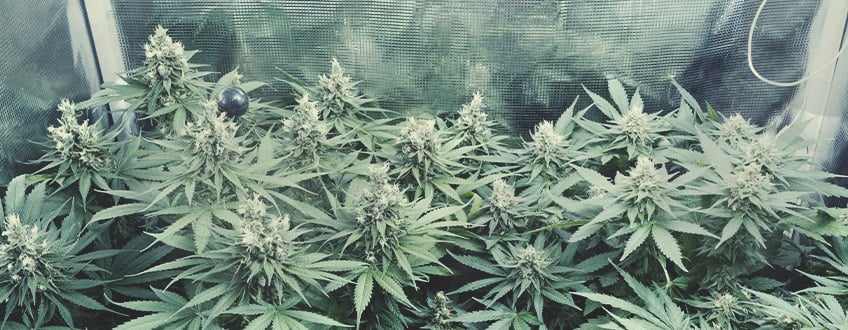
TOP THREE CBD STRAINS
The Royal Queen Seeds range features a variety of high-CBD strains: both photoperiod and autoflowering! Discover the top three below!
• Solomatic CBD produces sky-high levels of CBD.
Solomatic CBD
|
|
Diesel CBD x Asia CBD Auto |
|
|
150 - 200 gr/m2 |
|
|
50 - 100 cm |
|
|
7 - 8 weeks |
|
|
THC: 1% |
|
|
Sativa 20% Indica 70% Ruderalis 10% |
|
|
30 - 80 gr/plant |
|
|
60 - 100 cm |
|
|
10 – 11 weeks after sprouting |
|
|
Clear, Light |
• Medical Mass provides a huge yield indoors and outdoors.
Medical Mass
|
|
Critical Mass x CBD dominant plant |
|
|
500 - 550 gr/m2 |
|
|
60 - 100 cm |
|
|
10 - 11 weeks |
|
|
THC: 10% |
|
|
Sativa 40% Indica 60% |
|
|
500 - 550 gr/plant |
|
|
120 - 150 cm |
|
|
Late September |
|
|
Calming, Physically Relaxing |
• Tatanka Pure CBD oozes scrumptious terpenes.
Tatanka Pure CBD
|
|
Elixir Vitae x Medical CBD |
|
|
400 - 450 gr/m2 |
|
|
80 - 100 cm |
|
|
6 - 8 weeks |
|
|
THC: 0,15 - 0,25% |
|
|
Sativa 30% Indica 70% |
|
|
400 - 450 gr/plant |
|
|
100 - 160 cm |
|
|
Early October |
|
|
Calming, Clear |


























